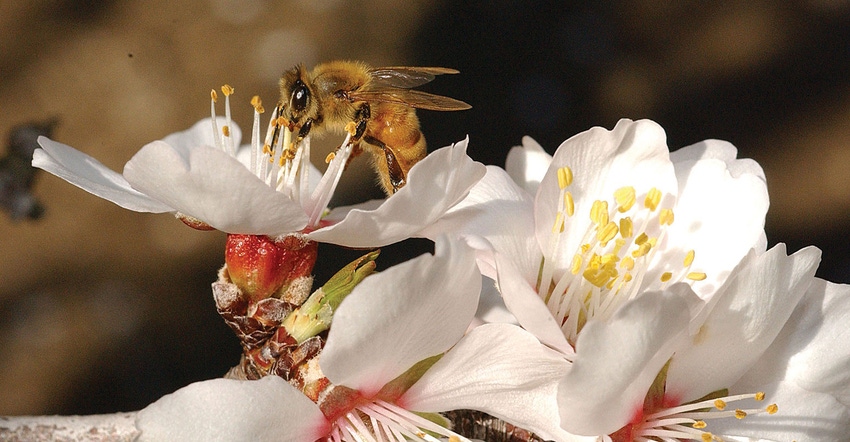
There’s a certain poetic symbolism about mid-February and what it represents (at least in non-COVID years) — the Daytona 500, the NBA All-Star Game, Jimmy Hoffa’s birthday, Valentine’s Day, and the presumptive kick-off of the almond pollination period in California.
If tradition holds, trucks loaded with beehives have already begun arriving.
“Delivering those hives is a logistical feat,” said Fiona Edwards Murphy of ApisProtect, which monitors honeybee colonies. “They’ve been on pallets carried by flatbed trucks via multi-day, cross-country journeys from as far away as Florida, a 3,000-mile trip involving overheating, overcooling, and a myriad of other stresses before they’re expected to go right to work.”
California has some 1.2 million bearing acres of almond trees. As another 300,000 acres come into production in the next few years, an additional 600,000 hives will be needed for pollination, which will be a daunting task, the California Farm Bureau Federation notes.
According to the National Honey Board: “Things should be buzzing as more than 80 billion honeybees are setting up shop in thousands of acres of almond trees. During the short growing season (mid-February to mid-March), approximately 85% of all available commercial hives make their way to California to pollinate 80% of the world’s almonds.
“Since almonds are 100% dependent on this pollination, this is considered to be the largest event in migratory beekeeping,” reports the Honey Board. While in sports, teams play games leading up to their biggest game of the season, almonds are just the kickoff to the pollination season as the bees, once the almonds have been cared for, pack up and head out to pollinate other crops in all 50 states, the board notes.
That said, the University of California Giannini Foundation of Agricultural Economics is reporting that, due to almond prices, “2021 pollination expenses will be scrutinized.”
“Pollination costs now represent a substantial share of annual operating expenses for almond operations, rivaling both irrigation and harvest costs,” write researchers Brittney Goodrich and Jennie Durant. “As of Fall 2020, prices are roughly 30% below their 5-year average of $2.90 per pound while pollination fees are 7% above their 5-year average of $183 per colony.”
88% of U.S. colonies
For the 2020 bloom, roughly 1.2 million almond acres required an estimated 2.4 million honeybee colonies for pollination. Of that number, 1.9 million colonies were shipped into California from other states. While those figures may change quickly based on other unexpected changes, the authors note: “In February 2021, an estimated 2.5 million colonies or approximately 88% of the total colonies in the U.S. will be required for almond pollination.”
In their report titled, “Going Nuts for More Bees”, they acknowledge: “As almond acreage has increased over time, so has the demand for honeybee colonies (with) pollination fees rising in response to this increasing demand to attract additional colonies.”
In Spring 2020, researchers at UC Davis and Duke University surveyed 321 almond growers and of this number, 273 reported renting some or all of their honeybee colonies for the previous pollination. The remainder were integrated almond/beekeeping operations with their own bees or had orchards not mature enough for pollination.
Of the three regional production centers [Sacramento Valley; Northern San Joaquin Valley, and Southern San Joaquin Valley], pollination needs differed. In Sacramento Valley, home to queen and packaged bee producers keeping colonies in California year-round, only a third of the respondents required out-of-state beekeepers.
The authors concluded their report by writing: “Contracting higher-strength colonies (above 8-frame strength) is associated with higher fees, but may allow growers to employ fewer colonies per acre.”
For more news on tree nuts as reported by growers and farm advisors, subscribe to the Tree Nut Farm Press e-newsletter.
About the Author(s)
You May Also Like




